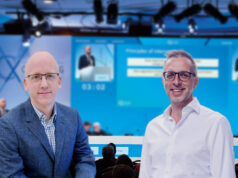
Peter Harris, the joint founder and chairman of the Eurostar registry of endovascular procedures for repair of abdominal aortic aneurysms, explained how having successfully completed its initial audit cycle Eurostar is taking on new functions.The Eurostar registry of endovascular procedures for repair of abdominal aortic aneurysms was inaugurated in 1996.
Peter Harris and Jaap Buth, who was the Secretary of the European Board of Vascular Surgery at that time, both got to know the French surgeon Claude Mialhe, who had seen the potential of a modular device for endovascular repair of aortic aneurysms, and had an interest in this area.
Harris explained: “We said to Mialhe, we have a problem here in establishing the validity of your results, and this is really important because the validity of the results will influence the evolution of this technology in the future. We have to make sure that results are published that are credible to a large number of people, because it is a major advance in surgical technology which has enormous potential benefit, so we must do something about this. Therefore, we decided that what was required was an independent audit of the results. We felt that we needed to make it Europe-wide because we needed to accumulate a lot of data as quickly as possible. In order to determine if it was good or bad we needed as much data as quickly as possible.”
Harris told Vascular News, “We now have over 7,000 patients registered in Eurostar and to date 135 different centers throughout Europe. It is no longer confined to European Union countries, now it is beyond Europe, for example Turkey and Israel. It has become a very big organization.”
Highlighting device failure
“Eurostar has made some really important contributions to the evolution of endovascular aneurysm repair,” said Harris, “really through the reporting of bad results. We did this at a time when it was unpopular to do this. The first generation devices failed. They failed because they were not structured to do the job. They failed because the metal from which the stents were made was too weak and the metal fractured. The stents were held together by sutures and the sutures broke, so that the component parts of the stent came apart. The fabric was too thin and developed holes in it. The mechanisms used to fix the devices in the body were also far too week, so the devices migrated.
“We monitored very carefully the outcomes, and from the data from thousands of patients we were not only able to measure the failure rate we were also able to do an in depth analysis for the reasons of failure, in other words the risk factors for failure. We found that only two things mattered, out of all of the possible factors that could influence failure of endovascular repair only two things mattered. One was migration of the device, i.e. how good the fixation mechanism is, and if the device migrated what happened when the seal, which protected the aneurysm from rupture, failed and the aneurysms ruptured, that was the most important thing. The second thing was the strength of the materials. If the fabric tore or the materials came apart then not surprisingly that contributed to rupture. We published all of this and these results were observed and taken into account by graft manufacturers, and now modern graft designs have compensated for those things. The metal is stronger, the fabric is stronger and most effective modern devices have really secure fixation mechanisms and we are seeing improved results.”
Harris continued, “Having indentified that there was a problem, we are now observing improved results as a consequence of that. This is audit truly working. This is audit in which the audit cycle has been completed. It has, to my knowledge, been one of the most successful audit projects of all time.”
New purposes
Explaining the need for Eurostar to evolve, Harris said. “The audit goes on, but now we are having to review the purpose of Eurostar. With 7,000 patients entered and the technology plateauing, we now feel it is not appropriate just to keep putting more and more patients in with the same devices that don’t change. Of course we need to follow the cohort of patients that we have got for 10-15 years but there is another function that Eurostar can perform now. It can look at different applications of endovascular repair and indeed any new technologies that do come out.”
He continued, “Things we are looking at specifically are:
Those are the three areas that Eurostar is either now concentrating on or intending to take on in the future.”
Harris also explained that the definitive results from EVAR Trial 1 due next year will have an impact on the role of Eurostar. “I am one of the applicants for the EVAR Trial sponsorship from the National Health Service Health Technology Assessment Board, and Roger Greenhalgh is the Chairman of the Trial Management Committee and the Principal Applicant. The first results have just been published, however, the most important results, that is the results upon which a decision can be made as to whether endovascular repair has an important role in the treatment of aneurysms or not, will be published in June 2005. The EVAR trials will answer the important questions that are outstanding relating to conventional endovascular repair of aortic aneurysms and to that extent, I think the importance of Eurostar will be diminished.”













